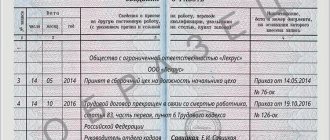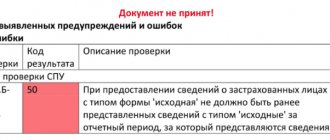Who can be fired by transfer?
Due to a transfer to another employer (clause 5, part 1, article 77 of the Labor Code of the Russian Federation), you can part with any employee with his consent, expressed in writing or his written request. On this basis, it is possible to terminate an employment agreement with a pregnant employee, an employee with young children, or someone who is on vacation or sick leave. This follows from clause 5, part 1, art. 77, part 2 art. 72.1, part 6 art. 81, part 1, 4 art. 261 Labor Code of the Russian Federation. Termination of an employment contract in a similar format can be initiated:
- employee;
- employer (current);
- employer (future).
General procedure for dismissal due to transfer
The procedure for dismissal under the terms of transfer to another employer consists of several steps.
| Step No. | Procedure for dismissal by transfer | Decoding |
| 1 | New employer: developing a letter inviting you to find a job with a new translation employer | The transfer letter consists of the following information:
|
| 2 | Current employer: developing a response letter on behalf of the current employer | The letter includes information about consent to the employee's transfer. Not required. Consent to the transfer can also be expressed on the letterhead from paragraph 1. |
| 3 | Employee: writing a letter of resignation due to transfer | The resignation letter for transfer includes information:
In the text of the application, you should make a reference to the invitation received from the new employer and attach a copy of it. |
| 4 | Current employer: issuance of a dismissal order by way of transfer | An order for dismissal based on transfer can be issued using standard forms T-8 or T-8a. The administrative document for dismissal in accordance with the established procedure must include:
|
| 5 | Current employer: entering information into the work book in the manner prescribed by the legislator, issuing it | The wording of the entry is made with reference to clause 5, part 1, art. 77 Labor Code of the Russian Federation. |
| 6 | Current employer: settlement with employee | Produced for the period worked and unused vacation days. |
Step-by-step instructions for dismissal by transfer
The main stages of dismissal are the same for all situations, however, each of them requires the preparation of different documents. Let's look at the features of their design.
Free legal consultation We will answer your question in 5 minutes!
Ask a Question
In general, the procedure follows the following algorithm:
Free legal consultation
We will answer your question in 5 minutes!
Ask a Question
- A request to transfer an employee is drawn up by the initiating company in free form according to the rules of business turnover. Requires a written response within the shortest possible time (usually up to 5 business days).
- Receiving a response from a potential employer. If it is negative, the employee has the right to resign of his own free will after working out the period established by law (2 weeks for ordinary employees and 1 month for managers). If the translation is agreed upon, you can begin documenting it.
- Obtaining written consent from the employee for the transfer. To do this, he is sent a proposal drawn up in free form, but with the obligatory indication of the date of transfer, place of new work and the proposed position.
- Drawing up an application for transfer.
- Drawing up a dismissal order for transfer to another organization using the unified T-8 form. In the “basis document” field, a reference is made to the letter from the second employer or the employee’s consent to change his place of work. In the “grounds” column, data is entered about the article of the Code under which the contract is terminated - clause 5, part 1, article 77 of the Labor Code of the Russian Federation.
- Calculation of due payments - the accountant draws up a note-calculation form T-61, which reflects the amount of compensation for vacation and wages for the last working month. On the last day, the organization makes a full settlement with the employee (Article 84.1 of the Labor Code of the Russian Federation). In cases where this is not possible, the unpaid amounts are deposited and given to the former employee no later than the next working day after applying for money (Article 140 of the Labor Code of the Russian Federation).
- Registration of a work book - information about the termination of the contract from the dismissal order is transferred to it. The work book is given to the dismissed person on the last working day. If the former employee does not show up for it, the organization will have to keep the document in his personal file.
- On the day the employment relationship ends, the former employee is given certificates in forms 2-NDFL, 182-, SZV-Experience, as well as copies of personnel documents (upon request).
Dismissal in unusual situations
If dismissal by transfer to another organization occurs during the employee’s illness, the employer is obliged to calculate and pay him temporary disability benefits within 10 days after the provision of sick leave.
This is also important to know:
Order of dismissal for absenteeism: procedure for execution and sample of filling out the order with explanations
Refusal to pay will result in penalties being imposed on the company. An employee who goes to court has the right to demand compensation in the amount of 1/300 of the refinancing rate of the Central Bank of the Russian Federation. The penalty begins to accumulate from the next day after the set date for payment of funds.
A complete guide to the dismissal procedure from ConsultantPlus
1. How to draw up an agreement to terminate an employment contract
By agreement of the parties, the employment contract can be terminated at any time within the period determined by the parties. This follows from the totality of the provisions of Art. 78 of the Labor Code of the Russian Federation, clause 20 of the Resolution of the Plenum of the Supreme Court of the Russian Federation dated March 17, 2004 N 2. The initiator of termination of the contract on this basis can be either the employee or the employer.
Read more
If the initiator is another organization
If a new employer applies for a transfer, he sends a request to the organization where the employee he is interested in works to consider the possibility of transferring him.
A letter proposing to terminate the contract by way of transfer on behalf of the new employer is generated in any form; there is no legally established template. Usually the document is drawn up on the letterhead of the initiating institution. The letter contains the following information:
- last name, first name, patronymic and position of the specialist invited to work;
- the name of the institution where the person is invited;
- text with a translation proposal;
- request to review the transfer letter within a limited period, the desired format for receiving a response;
- date of expected hiring;
- vacancy for which a subordinate is invited;
- signature of a person with appropriate authority (usually a manager).
The employing organization, having reviewed the letter, must respond with consent or refusal, as evidenced by the manager’s visa. The request is accompanied by the employee’s signature indicating agreement (or disagreement) with the proposed position.
If the decision is positive, the employer sends a response letter to the initiating party, which confirms both his and the employee’s consent.
A letter of consent to dismiss an employee by way of transfer is drawn up in any form; there is no legally established template. If the current employer does not object to dismissal by transfer, the letter, in addition to consent, should indicate the date of dismissal. Taking into account the content of Part 2 of Art. 72.1 of the Labor Code of the Russian Federation, before drawing up a letter of dismissal, it is necessary to obtain the employee’s consent (request) for the transfer. In addition, you can obtain a person’s consent to process and transfer his personal data to a third party (in order to avoid liability under Part 2 of Article 13.11 of the Code of Administrative Offenses of the Russian Federation).
The boss does not let the employee go: what to do
Not all managers are happy with dismissal as a transfer to another organization. It is clear that they will not interfere with a bad employee in such a situation, and they will not quickly let go of a good specialist. Unfortunately, if the employer refuses to confirm the transfer, the employee can only resign of his own free will.
Free legal consultation We will answer your question in 5 minutes!
Free legal consultation
We will answer your question in 5 minutes!
Ask a Question
Call: 8 800 511-39-66
The advantage of this situation is minimal paperwork upon dismissal. The downside is the lack of job guarantees for the future employer. The rule about hiring within 1 month after dismissal will not work in this case, and there will be no one to file a claim.
Is it necessary to write a letter of resignation in the order of transfer?
Dismissal upon transfer to another employer is regulated by clause 5 of part 1 of article 77 of the Labor Code of the Russian Federation. Its feature is a mandatory agreement between all parties involved in the process: the new and previous employers and the employee. The wording of personnel documents must specify exactly how the transfer through dismissal is carried out: at the request of the employee or with his consent. If a negative decision is made, the subordinate retains the right to terminate the employment contract at his own request.
If the initiator is an employee
The solution to the problem of transferring a specialist is not always given to organizations painlessly and without conflicts. Especially when it comes to a highly qualified professional. Therefore, the employees themselves are often involved in resolving all issues. You need to write a letter of resignation, accompanied by a job offer. After considering the request, the manager endorses the decision.
The employee must submit an appeal related to the desire to resign and transfer to a new job in writing (Part 2 of Article 72.1 of the Labor Code of the Russian Federation). The format is arbitrary, there is no template defined by the legislator.
After receiving an application, the employer should pay attention to the following factors:
- availability of full name and employee positions;
- a request to dismiss (consent to dismissal) under clause 5, part 1, art. 77 Labor Code of the Russian Federation;
- date of transfer to another employer.
Tripartite Agreement
The employee, employer and future employer can enter into a tripartite severance agreement for the transfer when no one objects. The execution of such a document on dismissal is not provided for by law. But it is widely used in business, as it significantly reduces the volume of paperwork: all conditions are included in one agreement, which speeds up the procedure.
The agreement is formed arbitrarily, since there is no legally established version of the form. The document includes:
- information about the parties - names of current and future employers, full name. employee;
- provisions on an agreement to dismiss a person by transfer and hire him to a new position (the day of dismissal, hiring, future position is prescribed);
- other conditions, for example, regarding vacations.
Issued in 3 copies (one for each). Each copy must be signed by all three participants.
Making an order
The procedure takes place as usual. The main thing is to correctly fill out, issue the necessary documents and make timely payments.
As a general rule, you can draw up an administrative document on dismissal using forms T-8, T-8a. It is acceptable to use your own order template.
The line containing the basis for termination of the agreement must be correctly reflected, using clause 5, part 1, art. 77 Labor Code of the Russian Federation.
| Dismissal format | Formulation |
| At the employee's request | Transfer of an employee at his request to work for another employer, clause 5 of part 1 of article 77 of the Labor Code of the Russian Federation |
| With the employee's consent | Transfer of an employee, with his consent, to work for another employer, clause 5 of part 1 of article 77 of the Labor Code of the Russian Federation |
When drawing up a dismissal order (clause 5, part 1, article 77 of the Labor Code of the Russian Federation), we must indicate exactly how the process is formalized: with the consent of the subordinate or at his request. The basis must refer either to the letter of request, indicating the date and originating document number, or to the employee’s application, as well as an invitation to work. The basis for issuing a dismissal order are all the papers that were used during the development process:
- letter of offer from a new employer;
- response letter with consent from the current one;
- employee statement;
- tripartite agreement.
The order must be presented to the employee against his signature. If this is not possible or if you refuse, you must make a note (Part 2 of Article 84.1 of the Labor Code of the Russian Federation).
Registration of a work book
The work book contains a record of the termination of the employment relationship and a link to the relevant article of the Labor Code of the Russian Federation. It is specified on whose initiative the translation is being carried out.
The receiving party enters the name of the organization, and then, under the new serial number, makes a record of the reception of the employee.
The registration is made according to the usual rules for registration. Column 3 includes information about the grounds for dismissal under clause 5, part 1, art. 77 Labor Code of the Russian Federation. All information is entered without abbreviations and certified by the signature of the responsible person and the seal of the company.
Features of the procedure and algorithm of actions
The terms of the transfer depend on which party is the initiator. The following documents are required for registration:
- statement from the employee
- invitation letter from a new employer
- written agreement between the new and old tenant (if the procedure was initiated by the tenant)
The documents indicate the name of the new company, position, job responsibilities, department, salary and working conditions.
If an employee refuses to transfer, the employer has the right to fire him. If you agree, you need to draw up an application and give written consent to the transition. The standard dismissal process follows.
Within one organization
When the transition takes place within the organization, the employee must give approval for this procedure. Next, the organization issues a transfer order. Important! Additional is definitely required. agreement is an agreement between an employee and an employer.
The transition within one company is not as straightforward as it seems. The fact is that this is legal, but in case of bad intent, as a result of such actions the employee may find himself without a job. And it will be impossible to challenge this even in court.
To another company
Before dismissing an employee and transferring him to a new employer, the manager must have grounds for this. If there is an invitation from the management of the new company, the current management may fire the transfer employee.
When an employee has a desire to leave for a transfer to another organization, and the current manager does not agree, then he can only leave of his own free will.
Important! When dismissal occurs due to transfer, the new organization must accept the employee, or he will have the right to go to court.
The former manager may oblige the employee to work for 2 weeks.
Step-by-step instruction
The mechanism of action in 2021 in case of dismissal with transfer at the initiative of an employee is as follows:
| The current employer initially receives a drafted invitation letter from the company | Which is interested in hiring a new worker. The document must be drawn up in any form on the letterhead of the future employer. It must indicate the future position and date of employment. Often the letter indicates the future salary, but this is optional |
| At the next stage, the worker who has expressed a desire to process the transfer | You must draw up a corresponding statement, which confirms your intentions. Please note - some employers limit themselves to receiving a letter of invitation and do not require an additional application. |
| After this, the current employer issues an Order | Which indicates on whose initiative the translation is being carried out. In particular, reference must be made to Article 77 of the Labor Code of the Russian Federation |
| At the next stage, the generated Order is subject to mandatory registration | In the corresponding internal document flow journal |
| Further with the compiled Order | The employer must inform the employee |
| At the next stage, in the employee’s personal card (according to T-2 form) | An appropriate entry must be made regarding the dismissal of the worker, in which it is also necessary to refer to Article 77 of the Labor Code of the Russian Federation. The hired worker must be familiarized with the records made in the manner prescribed by Russian legislation. The personal signature of the resigning person serves as confirmation |
| At the next stage, it becomes necessary to make an entry in the worker’s work book | Based on the established Instructions for filling. In 2018, several types of recording are provided, namely: “dismissal due to transfer, at the initiative of the employee, to employment with another employer on the basis of clause 5 of part 1 of Art. 77 Labor Code of the Russian Federation”; “the employment agreement was terminated at the initiative of the employee due to a transfer, for the purpose of employment with another employer, on the basis of clause 5 of part 1 of Art. 77 Labor Code of the Russian Federation.” In addition, in the personal work book you will need to indicate the number of the Order for dismissal of the employee and the date of its formation. The entry made should not be formed with any abbreviations, and must also be accompanied by the seal and personal signature of the official employer |
| On the last official working day | A full settlement is made with the worker by generating the appropriate settlement note (according to form T-61). It follows from this that the worker must receive payments in full on the last working day |
| Next, the employee is given a work book. | The fact of issuance is certified by affixing the personal signature of the dismissing person in the relevant Journal of internal document flow of the company |
| In addition to the employee's salary, the employer gives | Salary certificate for the last few months |
Based on official dismissal, a citizen has 30 days for subsequent employment in a new place.
When accepting a new job, the current employer must indicate the fact of the transfer in all available documentation.
Terms and guarantees
Dismissal by transfer to another organization has its own legal consequences and provides the employee with guarantees:
- If an employee is dismissed after moving to another organization, the new employer loses the right to refuse to hire such an employee and, on the contrary, is obliged to hire him within a month from the date of dismissal (Article 64 of the Labor Code of the Russian Federation).
- If the employee is accepted by transfer, then no test is established (Part 4 of Article 70 of the Labor Code of the Russian Federation), since it is considered that the invited specialist is highly qualified and meets the requirements for his position.
How is a transfer to another employer carried out?
The initiative to transfer to work with another employer can come from both the employee and the employer. The employee makes the corresponding request or gives consent only in writing, but in both cases, such a transfer entails the termination of the employment contract at the previous place of work on the basis of clause 5 of Art. 77 Labor Code of the Russian Federation. The party with whom the contract is terminated must comply with the procedure of Art. 84.1 of the Labor Code of the Russian Federation, namely, on the day of termination of the contract, issue the employee a work book, make payments to him in accordance with Art. 140 of the Labor Code of the Russian Federation and issue copies of work-related documents if a written application to this effect is received from the employee.
The following guarantees of employee rights must be observed in the new workplace:
- it is not allowed to conduct tests in connection with hiring (Article 70 of the Labor Code of the Russian Federation);
- it is prohibited to refuse invited employees to conclude an employment contract within a month from the date of dismissal from their previous place of work (Article 64 of the Labor Code of the Russian Federation);
- It is not allowed to withdraw a resignation letter at one's own request by an employee in whose place another employee has been invited by way of transfer (Article 80 of the Labor Code of the Russian Federation).
Advantages and disadvantages
For the employee, the positive aspects of the process include:
- guaranteed employment (the employer has no right to refuse employment, Article 64 of the Labor Code of the Russian Federation);
- absence of a trial period of 3 months (part 4 of article 70 of the Labor Code of the Russian Federation).
For the employer, there is no need to pay severance pay if a person is laid off, that is, an opportunity to save the budget.
The disadvantages of the dismissal process by transfer for an employee are:
- inability to return a letter of resignation if an agreement is drawn up. If a person has changed his mind and does not want to leave his employer, the problem will have to be resolved in an individual conversation with the signatories;
- inability to save leave during the transition;
- compensation is paid at the previous place; at the new place you can apply for leave after six months - Art. 122 Labor Code of the Russian Federation.
Types and classification of dismissal
Initially, it is necessary to pay attention to the presence of several types of dismissal due to transfer, in particular:
- External
- Internal
Let's look at them in more detail in the table:
| Type of translation | Explanation |
| Interior | A situation in which the employer remains the same, but there is a change in the position held, place of business, and so on. This type of transfer can be temporary or permanent. |
| External | It is carried out in the case when an employee decides to move from one employer to another. Moreover, in the new place he must have permanent employment (there can be no talk of a probationary period) |
For your information, regardless of the type of transfer, the consent of the worker is a mandatory criterion, otherwise the transfer occurs illegally.
There are several types of dismissal of transfer workers, their types depend on who is the initiator.
The employee himself found the company where he wants to work.
If the management of the new organization agrees to hire him, then they must send a letter of invitation to his previous place (addressed to the director of the company), which will confirm that they are ready to hire the employee.
Such notification is sent by mail or personally to the current director of the company. If the manager agrees, then the employee writes a letter of resignation in the order of transfer, on the basis of which a dismissal order is issued, an entry is made in the work book, personal card, and the employee is paid. Prepared and received by the employee (employment and 2-NDFL certificate for 2 years).
With this package of documents, the employee is sent to the next job.
The initiator is the director of the organization.
Sometimes a company urgently needs to reduce its workforce. Then the employer has the right to find a new place for the employee. Directors of organizations discuss all the details and request written consent from the employee. Afterwards, a tripartite agreement is signed, indicating the position, salary, etc. Afterwards, the usual transition procedure takes place.
Regulatory acts The process of dismissal and transfer is regulated by regulatory acts: clause 7 of Art. 77 Labor Code of the Russian Federation. This type of termination of an employment agreement is more complicated than ordinary dismissal at will, and has more nuances. Therefore, it is extremely important to carefully approach the registration of documentation. Internal transfer is regulated by Part 3 of Art. 72.1 Labor Code of the Russian Federation.
Refusal to hire from new employer
Article 64 of the Labor Code of the Russian Federation gives the employee a guarantee of employment. The potential employer who sent the invitation does not have the right to change the decision and refuse to hire the employee.
An invitation to move to a new place and a person’s written consent will become documents that guarantee employment. If the new employer still refuses to hire, the employee has the right to file a complaint with the labor inspectorate or send a statement of claim to the court. If the decision is positive for the employee, the court will establish the obligation for the employer to conclude an employment agreement from the date following the date of dismissal from the previous place.
Transfer at the initiative of the employee
Dismissal by transfer can also be carried out on the initiative of the employee himself, which is advisable, since for an employee this method of terminating the employment relationship has many advantages, including:
- the time during which the employee will be guaranteed to be hired at a new place of work - a month from the date of dismissal;
- hiring without a probationary period.
The refusal of the receiving party to employ the transferred employee may result in administrative sanctions, which are prescribed in Part 4 of Art. 5.27 Code of Administrative Offenses of the Russian Federation:
- for officials: fine from 10,000 to 20,000 rubles;
- for persons carrying out entrepreneurial activities without forming a legal entity: a fine from 5,000 to 10,000 rubles;
- for legal entities: fine from 50,000 to 100,000 rubles.
If the employee himself wants to transfer to another company, the procedure is formalized as follows:
- he submits an application with a request to dismiss him by way of transfer to another organization;
- the employer agrees on the employment opportunity with the company to which his employee wants to move;
- the dismissal procedure is initiated, which follows the general rules described above. The only difference: in the dismissal order and in the work book it is written about.
If a labor conflict arises, the employee is given the right to appeal to judicial structures for 3 months from the date on which he learned that his rights were violated in accordance with Art. 392 Labor Code of the Russian Federation. But it is recommended that you first come for a consultation with the Labor Inspectorate to find out whether the issue can be resolved peacefully using pre-trial procedures.











